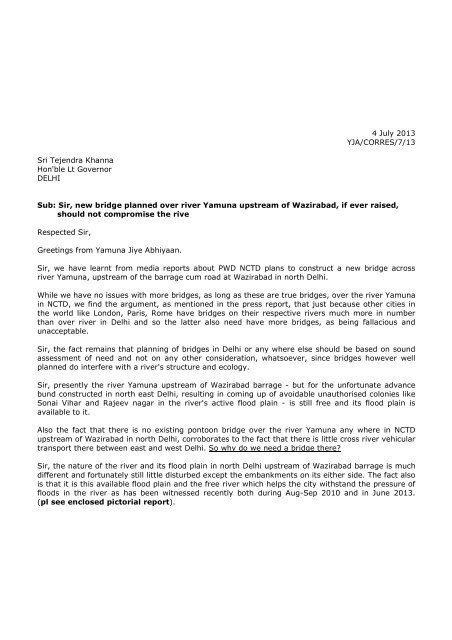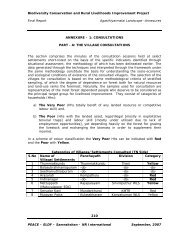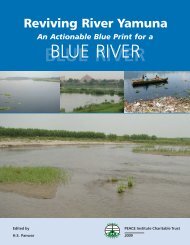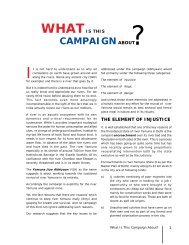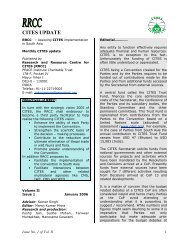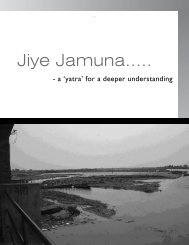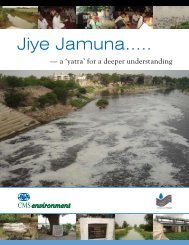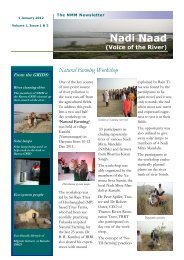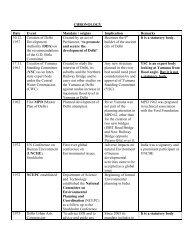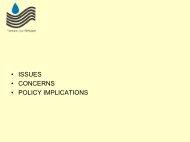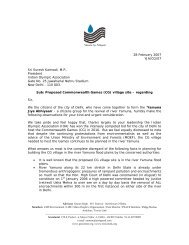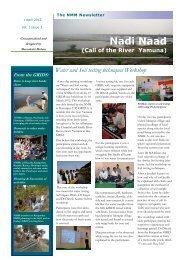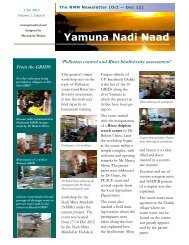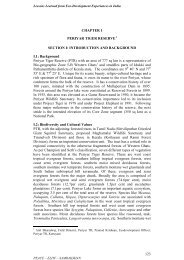Letter to Hon'ble LG _new bridge planned over river Yamuna _ - 4.7 ...
Letter to Hon'ble LG _new bridge planned over river Yamuna _ - 4.7 ...
Letter to Hon'ble LG _new bridge planned over river Yamuna _ - 4.7 ...
You also want an ePaper? Increase the reach of your titles
YUMPU automatically turns print PDFs into web optimized ePapers that Google loves.
4 July 2013<br />
YJA/CORRES/7/13<br />
Sri Tejendra Khanna<br />
<strong>Hon'ble</strong> Lt G<strong>over</strong>nor<br />
DELHI<br />
Sub: Sir, <strong>new</strong> <strong>bridge</strong> <strong>planned</strong> <strong>over</strong> <strong>river</strong> <strong>Yamuna</strong> upstream of Wazirabad, if ever raised,<br />
should not compromise the rive<br />
Respected Sir,<br />
Greetings from <strong>Yamuna</strong> Jiye Abhiyaan.<br />
Sir, we have learnt from media reports about PWD NCTD plans <strong>to</strong> construct a <strong>new</strong> <strong>bridge</strong> across<br />
<strong>river</strong> <strong>Yamuna</strong>, upstream of the barrage cum road at Wazirabad in north Delhi.<br />
While we have no issues with more <strong>bridge</strong>s, as long as these are true <strong>bridge</strong>s, <strong>over</strong> the <strong>river</strong> <strong>Yamuna</strong><br />
in NCTD, we find the argument, as mentioned in the press report, that just because other cities in<br />
the world like London, Paris, Rome have <strong>bridge</strong>s on their respective <strong>river</strong>s much more in number<br />
than <strong>over</strong> <strong>river</strong> in Delhi and so the latter also need have more <strong>bridge</strong>s, as being fallacious and<br />
unacceptable.<br />
Sir, the fact remains that planning of <strong>bridge</strong>s in Delhi or any where else should be based on sound<br />
assessment of need and not on any other consideration, whatsoever, since <strong>bridge</strong>s however well<br />
<strong>planned</strong> do interfere with a <strong>river</strong>'s structure and ecology.<br />
Sir, presently the <strong>river</strong> <strong>Yamuna</strong> upstream of Wazirabad barrage - but for the unfortunate advance<br />
bund constructed in north east Delhi, resulting in coming up of avoidable unauthorised colonies like<br />
Sonai Vihar and Rajeev nagar in the <strong>river</strong>'s active flood plain - is still free and its flood plain is<br />
available <strong>to</strong> it.<br />
Also the fact that there is no existing pon<strong>to</strong>on <strong>bridge</strong> <strong>over</strong> the <strong>river</strong> <strong>Yamuna</strong> any where in NCTD<br />
upstream of Wazirabad in north Delhi, corroborates <strong>to</strong> the fact that there is little cross <strong>river</strong> vehicular<br />
transport there between east and west Delhi. So why do we need a <strong>bridge</strong> there?<br />
Sir, the nature of the <strong>river</strong> and its flood plain in north Delhi upstream of Wazirabad barrage is much<br />
different and fortunately still little disturbed except the embankments on its either side. The fact also<br />
is that it is this available flood plain and the free <strong>river</strong> which helps the city withstand the pressure of<br />
floods in the <strong>river</strong> as has been witnessed recently both during Aug-Sep 2010 and in June 2013.<br />
(pl see enclosed pic<strong>to</strong>rial report).
Sir, it is also important that in the interest of the safety of the city downstream of Wazirabad, the<br />
integrity of the <strong>river</strong> and its water spread upstream of Wazirabad is not allowed <strong>to</strong> be compromised<br />
since in the eventuality of a massive release of say 9-10 lakh cusec at Hathnikund barrage (very<br />
much in the realm of possibility in the light of more than 8 lakh cusec seen in June 2013), which<br />
would mean more than 5 lakh cusec water reaching the city it may be necessary for the safety of the<br />
city <strong>to</strong> open some embankments <strong>to</strong> permit spread of water in farms and lands beyond the<br />
embankments in zone P II. Thus compromising of the integrity of the <strong>river</strong> system through raising of<br />
any structure including a <strong>bridge</strong> in north Delhi (Zone P II) is risky and inadvisable.<br />
Now in an unlikely scenario, where expert studies do necessitate a <strong>bridge</strong> <strong>over</strong> the <strong>river</strong> <strong>Yamuna</strong><br />
upstream of Wazirabad in Delhi, then such a <strong>bridge</strong> may only be a long (no less than 5 km between<br />
embankments as has been held by the <strong>Yamuna</strong> Standing Committee way back in 1979) and a true<br />
<strong>bridge</strong> <strong>over</strong> pillars all along its length (with no guide bund in between <strong>to</strong> channelise the <strong>river</strong> in any<br />
manner) so that the <strong>bridge</strong> does not inhibit the flow and spread of flood waters in any manner.<br />
Unfortunately all the <strong>bridge</strong>s presently in the city <strong>over</strong> the <strong>river</strong> are with the sole exception of under<br />
construction DMRC <strong>bridge</strong> downstream of HNZ <strong>bridge</strong>, are 'pseudo <strong>bridge</strong>s' (please peruse our<br />
enclosed report on it) where they have on one hand channelised the <strong>river</strong> and on the other<br />
created avoidable cross embankments in the <strong>river</strong> in form of raised roads. Such poorly <strong>planned</strong><br />
<strong>bridge</strong>s are not good for the <strong>river</strong> as well as for themselves during very high flows. Here allow us <strong>to</strong><br />
mention that both the <strong>bridge</strong>s on <strong>river</strong> <strong>Yamuna</strong> at Kalanour (<strong>Yamuna</strong>nagar) and at Mawi (Panipat-<br />
Kairana) faced trouble and closure <strong>over</strong> extended periods in 2010 and 2013 respectively due <strong>to</strong><br />
design faults, where cautionary additional spans could have avoided the damage and trouble faced<br />
both by the <strong>bridge</strong>s and the people using it.<br />
Sir, we hope that your goodself shall see merit in our submission and accordingly caution the<br />
concerned authorities.<br />
With warm regards,<br />
Manoj Misra<br />
Convener<br />
CC:<br />
Smt Sheila Dixit, <strong>Hon'ble</strong> Chief Minister of Delhi – For your kind information and necessary action please.<br />
Chairman, <strong>Yamuna</strong> Standing Committee, Central Water Commission, Sewa Bhawan, R.K. Puram, New<br />
Delhi – For your kind information and necessary action please.<br />
Chairman, Delhi Urban Arts Commission, India Habitat Centre, Lodhi Road, New Delhi – 110 003 – For<br />
your kind information and necessary action please.<br />
Vice Chairman, Delhi Development Authority – For your kind information and necessary action please.
Introduction<br />
WHY ‘PSEUDO’ BRIDGES ARE UNDESIRABLE OVER THE RIVER YAMUNA?<br />
Manoj Misra*<br />
A <strong>bridge</strong> <strong>over</strong> a <strong>river</strong> is a man made structure <strong>to</strong> enable safe and easy conveyance of man and<br />
material across a <strong>river</strong>.<br />
Thus the purpose of a <strong>bridge</strong> is <strong>to</strong> convey. It is not <strong>to</strong> obstruct the <strong>river</strong> in its natural course and<br />
functions. Most importantly, it must not restrict by design the unhindered spread and flow<br />
downstream of the flood waters. This is the reason why a ‘true’ <strong>bridge</strong> would span <strong>over</strong> the entire<br />
known flood plain of a <strong>river</strong> from it’s one bank <strong>to</strong> the other. It is also the reason why a smart<br />
engineer would choose the narrowest portion of a <strong>river</strong> <strong>to</strong> build a <strong>bridge</strong> <strong>over</strong> it and plan a road or<br />
railway’s alignment in the manner. But now a days especially in an urban setting with roads and<br />
railways (Metro in particular) criss-crossing every part of a city, such smart choices of sites for<br />
<strong>bridge</strong>s get remoter by the day.<br />
Situation of <strong>river</strong> in urban Delhi<br />
It is admitted that there can certainly be <strong>bridge</strong>s built <strong>over</strong> just the lean season channel of a <strong>river</strong><br />
provided the approach road <strong>to</strong> them is no higher than the natural level of the <strong>river</strong> bed, so that<br />
these in times of floods do not act as cross embankments <strong>to</strong> the flow downstream of a <strong>river</strong> in spate.<br />
And there were such examples of pon<strong>to</strong>on <strong>bridge</strong>s built annually at Majnu Ka Tila, Gita colony,<br />
Bhairon Road and Sarai Kale Khan till recent times, but none of these ever proved <strong>to</strong> be a hindrance<br />
<strong>to</strong> the flow of flood waters in the city since their approach roads followed the natural con<strong>to</strong>ur and<br />
level of the <strong>river</strong> bed.<br />
But the unscientific and hence unfortunate state of the <strong>bridge</strong>s <strong>over</strong> the <strong>river</strong> <strong>Yamuna</strong> in the 22 km<br />
stretch of the <strong>river</strong> in the city is that but for the British built <strong>bridge</strong> (old <strong>Yamuna</strong> Bridge joining<br />
Salimgarh Fort <strong>to</strong> Shahdara area) none of the other existing 7 <strong>bridge</strong>s (ISBT, DMRC Shastri Park,<br />
Gita Colony, DMRC <strong>Yamuna</strong> Bank, New Railway Bridge, HNZ Bridge, DND flyway) or under<br />
construction Signature Bridge is a ‘true’ <strong>bridge</strong>. They are all cross embankments raised on the <strong>river</strong>,<br />
with the <strong>bridge</strong> portion c<strong>over</strong>ing just the <strong>river</strong>s’ lean season channel of 500 – 800 m span against its<br />
actual length of 2.5 – 3 km. This it appears has been done on the lines of the 3 barrages standing on<br />
the <strong>river</strong> in the city, namely the ones at Wazirabad, ITO and at Okhla. But while a ‘barrage’ is meant<br />
<strong>to</strong> hold and divert water from a <strong>river</strong>, a ‘<strong>bridge</strong>’ is not. So when cross embankments in the <strong>river</strong> get<br />
built in the name of <strong>bridge</strong>s (pseudo) then they <strong>to</strong>o begin <strong>to</strong> act like barrages and lead <strong>to</strong> the<br />
following objectionable and undesirable results?<br />
Channelisation of the <strong>river</strong><br />
It may be noted that the <strong>river</strong> <strong>Yamuna</strong> has a natural tendency <strong>to</strong> meander within its flood plains. In<br />
the 22 km stretch of the <strong>river</strong> in Delhi it has a pronounced meander whereby the <strong>river</strong> channel shifts<br />
repeatedly from west <strong>to</strong> east and <strong>to</strong> west again.
Natural meander in the <strong>river</strong> in 22 km of <strong>river</strong> in urban Delhi<br />
The creation of pseudo <strong>bridge</strong>s on it results in ‘fixing’ and ‘freezing’ in time and space the current<br />
<strong>river</strong> meander within the guide bunds of the existing pseudo <strong>bridge</strong>s and thus effectively<br />
‘channelises’ the <strong>river</strong>. It may be noted that such ‘channelisation by default’ of a naturally<br />
meandering <strong>river</strong> could prove deleterious <strong>to</strong> the <strong>bridge</strong>s themselves during the times of floods.<br />
Today in most parts of the world where such past channelisation had been carried out, it is being<br />
scoffed at and actively discouraged after their sad experiences of devastations from the floods made<br />
worse due <strong>to</strong> the channelisation of their naturally meandering <strong>river</strong>s.<br />
It is a strange irony that while the state policy in the city as enshrined in the Master Plan (MPD<br />
2021) has abandoned the concept of channelisation of the <strong>river</strong> after actively pursuing it in the<br />
1990s, it continues <strong>to</strong> practice channelisation by default in form of the construction of pseudo<br />
<strong>bridge</strong>s on the <strong>river</strong>.<br />
Is it <strong>to</strong>o much <strong>to</strong> ask our planners <strong>to</strong> learn from the mistakes of others and <strong>to</strong> safeguard our flood<br />
plains while we still have them, rather lament later when all would have been lost?<br />
Avoidable, unnecessary and even risky impoundment of flood waters<br />
When <strong>bridge</strong>s (pseudo) start <strong>to</strong> function as barrages, the obvious outcome is the impoundment of<br />
flood waters behind their raised approach roads cum cross embankments. In normal course this<br />
flood water should have after spreading <strong>over</strong> the flood plain, flowed down the stream in channels<br />
more than one (many of which become active in times of floods) during the times of floods.<br />
Such an artificial and avoidable impoundment of water plays havoc with the underlying aquifer<br />
system and <strong>over</strong>-saturates them in no time.<br />
Often such short and quick time <strong>over</strong>-saturation of aquifers (unless pumped out in quick time) could<br />
prove disastrous for nearby structures including residential buildings by submerging their<br />
foundations with standing water. The most unfortunate incident on 15 November 2010 in the Lalita
Park locality of East Delhi, where a 5 s<strong>to</strong>ry building came tumbling down for reasons much more<br />
than poor construction quality and claimed 71 unsuspecting victims is a case in point.<br />
Temptation <strong>to</strong> encroach upon and build on ‘reclaimed’ (sic) flood plains<br />
It is no secret that the remaining flood plain of the <strong>river</strong> in urban Delhi is eyed by the developmental<br />
agencies of the state and non state interests alike, for reclamation and development (sic) in form of<br />
construction and concretisation. And such channelisation of the <strong>river</strong> through construction of pseudo<br />
<strong>bridge</strong>s helps them in their eagerness <strong>to</strong> reclaim and build. Past experiences like the DMRC<br />
complexes at both Shastri Park and at <strong>Yamuna</strong> bank, the Akshardham, the Games Village for CWG<br />
2010 and the DTC bus depot in the <strong>river</strong> bed are pointers in the matter. It may be noted that only if<br />
the existing <strong>bridge</strong>s on the <strong>river</strong> had been ‘true’ <strong>bridge</strong>s, none of the above state sponsored<br />
encroachments in the flood plain would even have been thought of in the active flood plain of the<br />
<strong>river</strong>.<br />
The NEERI report<br />
The National Environmental Engineering Research Institute, NEERI at Nagpur, was commissioned a<br />
study in 1998 of the 22 km stretch of the <strong>river</strong> in Delhi by the Delhi Development Authority (DDA).<br />
The purpose was <strong>to</strong> suggest a plan for the rejuvenation of the <strong>river</strong>. NEERI after a detailed study<br />
found and suggested the following:<br />
“The <strong>river</strong> has lost its carrying capacity <strong>to</strong> safely convey the highest floods expected in the city and<br />
hence the <strong>river</strong> bed’s natural <strong>to</strong>pography must not be compromised in any manner”.<br />
The <strong>Yamuna</strong> Standing Committee (YSC)<br />
It is a sad fact that the <strong>Yamuna</strong> Standing Committee (YSC) which is an inter-state expert body in the<br />
Central Water Commission (CWC) and is charged with the responsibility for the <strong>river</strong> has often<br />
succumbed <strong>to</strong> the pressure tactics of different state g<strong>over</strong>nments and sometimes even compromised<br />
on its own set norms. The following words of the then Chairman of the YSC at its 68 th meeting is an<br />
indication enough of the <strong>to</strong>ugh task at hand of the YSC:<br />
“The Chairman expressed his concern about the tendency of various developmental agencies <strong>to</strong><br />
encroach the flood plains of <strong>river</strong> <strong>Yamuna</strong>”.<br />
The YSC often goes by the advice received from the Pune based CWPRS (Central Water and Power<br />
Research Station), a central g<strong>over</strong>nment agency, which assesses different developmental proposals<br />
from the point of view of upstream afflux that might result in times of floods from the construction of<br />
a structure. Now as is well known that afflux is just one of the many impacts of a structure standing<br />
in a <strong>river</strong> bed and hence it cannot and should not be treated as an enough and sufficient assessment<br />
for a fully informed decision making by the YSC. More <strong>over</strong> we feel that the YSC should also have<br />
expert ecologists and <strong>river</strong> experts on its decision making panel.<br />
We at YJA had been given an opportunity by the <strong>Yamuna</strong> Standing Committee (YSC) <strong>to</strong> present our<br />
view points at its 74 th meeting held on 15 th July 2008 and we hope that our pleadings for the <strong>river</strong><br />
had its impact in that it (YSC) approved the proposal of PWD for the construction of a <strong>new</strong> road<br />
<strong>bridge</strong> across the <strong>river</strong> <strong>Yamuna</strong> at 1600 m upstream of existing HNZ road <strong>bridge</strong> subject <strong>to</strong> the<br />
condition that the approach road on left side of <strong>river</strong> <strong>Yamuna</strong> should be constructed on<br />
stilts (i.e, on piers) <strong>to</strong> allow flood water <strong>to</strong> flow freely.
The situation of the flood plain during the floods of 2010<br />
It may be recalled that the floods of Aug – Sep 2010 were in the nature of major floods in the <strong>river</strong><br />
in the city when the water level in the city <strong>to</strong>uched 207.11 m against the all time recorded high of<br />
207.44 m in the year 1978.<br />
It is a recorded fact that the entire available flood plains in the city went under deep waters as a<br />
result of the said floods.<br />
A view of the ‘flooded’ flood plains in <strong>river</strong> <strong>Yamuna</strong> in Delhi from<br />
the <strong>over</strong> <strong>bridge</strong> near Akshardham dated 13 Sep 2010<br />
Suggestions<br />
Against the above observations and the prediction of various models of high and frequent floods<br />
from the imminent impacts from Climate Change, it is suggested that no more ‘pseudo’ <strong>bridge</strong>s may<br />
be permitted <strong>to</strong> be built in the <strong>river</strong> bed. And the condition of approach road on stilts as specified by<br />
the YSC in its 74 th meet must be stipulated for any <strong>new</strong> <strong>bridge</strong> across the <strong>river</strong> <strong>Yamuna</strong> in the city.<br />
There is even a case <strong>to</strong> consider opening up of few clearings in the existing pseudo <strong>bridge</strong>s in the<br />
city for the ease of safe downstream flow of flood waters.<br />
*Manoj Misra is the Convener of <strong>Yamuna</strong> Jiye Abhiyaan.
SPREAD OF WATER UPSTREAM OF WAZIRABAD DURING 2013 FLOODS<br />
Water spread near Palla village. 19.06.13<br />
Near Jhangola Village. 19.06.13
Near Hiranki village. 19.06.1


